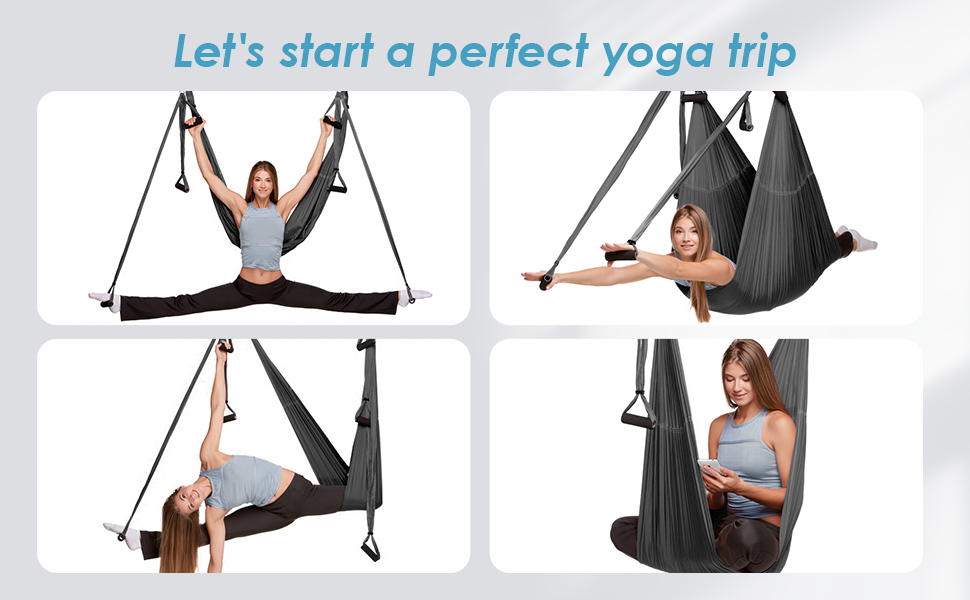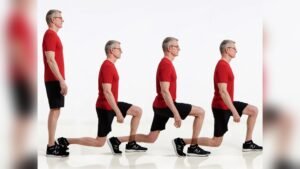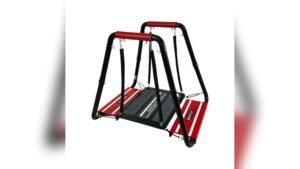Hey there, fitness enthusiast! Have you ever wondered about the difference between an aerial yoga hammock and a trapeze swing? I frequently heard people have so much doubt about the difference between aerial hammocks and yoga swings. If you’re here, you’re likely curious about aerial fitness, particularly aerial yoga hammocks, and trapeze swings. I’ll dive into the nitty-gritty of these two unique and exciting fitness tools, their benefits, differences, and similarities, along with some safety tips. So, let’s get started together!
Table of Contents
ToggleUnderstanding aerial hammock
An aerial yoga hammock, also known as a flying yoga hammock, is a piece of high-strength fabric suspended from the ceiling. It allows practitioners to perform various yoga poses in mid-air. The hammock’s versatility and support make it a favorite among aerial yoga novices and enthusiasts.
The genesis of aerial hammocks dates back to the early 2000s when New York-based choreographer and aerial performer Christopher Harrison integrated yoga with aerial arts. Since then, the aerial hammock has soared in popularity, with countless fitness studios worldwide offering aerial yoga classes.
The aerial hammock, also known as aerial silks, has its roots in aerial arts and circus performances. It is a long fabric rigged securely at both ends, creating a safe and supportive structure for various aerial movements.
“Aerial hammocks are usually made from robust materials like nylon or silk. These hammocks provide flexibility for users. They enable participants to hang, wrap, and move their bodies in different ways.”
One of the main purposes of the aerial hammock is aerial yoga, a practice that combines traditional yoga poses with aerial movements. Aerial hammock classes often incorporate Pilates, gymnastics, and dance elements, offering a unique and dynamic workout for the whole body. This apparatus can also be used for aerial silks performances involving captivating and gravity-defying acrobatic maneuvers.
The unique features and characteristics of the aerial hammock make it a popular choice for aerial enthusiasts. “It can support the full weight of the body, enabling various movements. These movements can make the core muscles stronger. They also help to increase flexibility and better body awareness.”
The aerial hammock offers a thrilling and challenging workout experience, from inversions and backbends to flips and drops.
Let’s talk about the benefits. Engaging with an aerial hammock can unlock physical and mental benefits. On the physical side, you can expect improved flexibility, enhanced core strength, and spine decompression. Mentally, many practitioners report reduced stress, increased relaxation, and a boost in overall mood. Scroll down to learn more about aerial hammock benefits.
And the poses? Some popular ones include the aerial pigeon, inverted straddle, and spinal decompression. Each pose offers unique benefits, from stretching tight muscles to realigning your spine.
However, safety should be your top priority when practicing aerial yoga. It’s crucial to set up your hammock correctly, following the recommended yoga swing installation ceiling instructions. Also, knowing your physical limits, warming up before each session, and having a spotter nearby can help prevent injuries.
Understanding Yoga Trapeze
Next up is the yoga trapeze, often called a swing or trapeze yoga. It’s a swing-like gadget that allows you to hang from it in various positions. Unlike the aerial hammock, the yoga trapeze has handles at different lengths for more grip variation.
The yoga trapeze is said to have its roots in traditional Hatha yoga practices. However, its modern incarnation was popularized by YOGABODY founder Lucas Rockwood in 2009. Since then, it has become a staple in many yoga studios worldwide.
Unveiling the Yoga trapeze/ Swing
The yoga swing, on the other hand, is deeply rooted in traditional yoga practices. It consists of a fabric swing with multiple handles and straps that can be securely attached to a sturdy frame or ceiling mount. The construction and materials used for yoga swings are similar to those of the aerial hammock, ensuring stability and durability.
Yoga swings are primarily designed to provide spinal traction, which is beneficial for decompressing the spine and relieving tension in the back. Using the swing as a support prop, practitioners can safely perform various stretches and poses targeting the spinal column. In addition to spinal traction, yoga swings are also used for inversions, backbends, and modifications of traditional yoga poses, allowing practitioners to deepen their practice safely and controlled.
The unique features of yoga swings make them particularly suitable for individuals with back issues or limited mobility. The gentle traction the swing provides can alleviate compression in the spine and promote better spinal alignment. The swing’s ergonomic design allows for more movement. This makes it easier for people who have flexibility issues to do different poses
Like the aerial hammock, the yoga trapeze offers many benefits(With weight loss). Physically, you’ll notice increased upper body strength, core power, and flexibility. It helps improve mental focus, aids in stress reduction, and promotes a heightened feeling of wellness.
The yoga trapeze allows for various poses, from beginner to advanced. Some popular yoga swing poses include the upside-down bow, aerial splits, and jackknife. Each pose targets different muscle groups, offering a full-body workout.
Safety is just as crucial with the yoga trapeze. Ensure your trapeze is correctly installed, and always have a spotter present, especially when trying out new or challenging poses.
Stay tuned for the next installment, where we’ll compare the aerial hammock and yoga trapeze.
“Find balance in the air and beyond as you soar to new heights with the aerial hammock and yoga swing! Discover the power of suspended fitness and uncover a whole new world of strength and serenity. Dive into our blog post to swing into a healthier, happier you!“
https://fitnessrights.com/blog-2/
Comparing Key Differences between Aerial Hammocks and Yoga Swings
While both the aerial hammock and the yoga swing are aerial apparatuses that offer benefits to the body and mind, there are some key differences between the two:
Structure and Design:
The aerial hammock consists of a single fabric rigged securely at both ends, allowing for more flexibility and versatility in movement. Conversely, the yoga swing typically has multiple handles and straps, providing more stability and support during yoga poses and stretches.
Support and Suspension:
Aerial hammocks generally offer full body weight support, providing a more immersive and challenging workout experience. On the other hand, yoga swings are designed for partial body weight support, focusing on specific areas such as the spine.
Movements and Poses:
The aerial hammock allows for a broader range of movements, including inversions, drops, flips, and wraps. It offers more creative freedom for aerial enthusiasts exploring dynamic and acrobatic poses. Yoga swings, on the other hand, are primarily used for spinal traction, inversions, and modified yoga postures that target specific areas of the body.
Difficulty and Skill Requirements:
The aerial hammock is generally considered more challenging and requires certain strength, flexibility, and body coordination. Yoga swings, however, offer a gentler approach to aerial fitness and can be accessible to individuals with varying fitness levels and abilities.
Exploring the Benefits of Aerial Hammocks
The aerial hammock offers a plethora of benefits for the mind and body. Here are some advantages that come with incorporating the aerial hammock into your fitness routine:
Physical Benefits:
– Increased flexibility: The varied movements and stretches performed on the aerial hammock help improve overall flexibility, including an increased range of motion in joints.
– Enhanced strength: Maneuvering your body in suspension requires engaging multiple muscle groups, leading to improved whole-body strength.
– Body awareness: The aerial hammock challenges your proprioception and body awareness, fostering a deeper connection between mind and body.
Mental and Emotional Benefits:
– Stress reduction: Engaging in aerial hammock workouts can serve as a form of stress relief, as it requires focus and concentration, allowing you to escape daily worries.
– Improved concentration: The aerial hammock demands concentration and mental focus, enhancing overall cognitive abilities and sharpening your mind.
Therapeutic Applications:
– Injury recovery and rehabilitation: The aerial hammock can assist in the recovery process for individuals with certain injuries, strengthening weakened muscles and improving mobility.
Unraveling the Benefits of Yoga Swings
Like the aerial hammock, yoga swings provide numerous benefits for your physical and mental well-being. Here are some advantages associated with using yoga swings in your fitness routine:

Image courtesy of www.amazon.com via Google Images
Physical Benefits:
– Spinal health: The traction provided by yoga swings can help decompress the spine, alleviate disc pressure, and promote spinal alignment.
– Posture improvement: Regular yoga swings can help correct poor posture habits, resulting in a more aligned and upright posture.
– Increased core strength: Stabilizing and engaging the core muscles during yoga swing exercises contributes to overall core strength development.
Mental and Emotional Benefits:
– Stress relief: Just like the aerial hammock, using a yoga swing also provides stress-relieving benefits, allowing you to disconnect from daily stressors and find tranquility.
– Mood regulation: The inversions and deep stretches facilitated by yoga swings can stimulate the release of endorphins, promoting happiness and overall well-being.
Suitable for Specific Individuals:
– Individuals with back issues: The gentle traction provided by yoga swings can help individuals with chronic back pain or discomfort find relief and improve spinal health.
– Limited mobility: The accessibility and versatility of yoga swings make them an excellent choice for individuals with limited mobility or range of motion due to age or injury.
Choosing the Right Option for You
When deciding between the aerial hammock and the yoga swing, it is essential to consider your preferences, fitness goals, and physical limitations. Here are some guidelines to help you make an informed decision:
1. Consider your goals: Determine what you hope to achieve in your fitness journey. The aerial hammock may be the better choice if you are seeking a more dynamic and acrobatic workout experience. However, the yoga swing may be more suitable if you are looking for spinal traction and modifications to traditional yoga poses.
2. Consider any injuries or limitations: If you have any existing injuries or physical limitations, consult a healthcare professional before deciding on an aerial apparatus. They can guide you on which option may be more appropriate for your needs.
3. Try both options: Try the aerial hammock and yoga swing to get a firsthand experience of how each feels and what benefits they offer. Attend a class or hire a qualified instructor to guide you through the movements and help you assess which option resonates best with you.
In conclusion, the aerial yoga hammock and yoga trapeze offer unique and effective ways to enhance your fitness regimen. They provide similar benefits but differ in design and function. When choosing between the two, consider your personal fitness goals, available space, and comfort level with aerial exercises. Remember, safety is paramount. So, whether you’re performing beginner yoga swing poses or advanced moves, ensure your equipment is securely installed.
Whether you choose a hammock or trapeze, you’ll add a fun, challenging, and effective tool to your fitness arsenal. So why wait? Take a swing at aerial yoga today.
Sources
- www.thedailyworld.com
- www.forbes.com
- www.mayoclinic.org
- www.everydayhealth.com
- www.nccih.nih.gov
The first Image courtesy of gravotonics.com via Google Images







